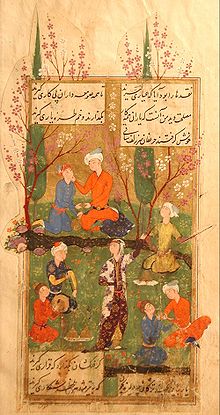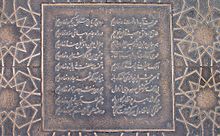Hafez

Hafis or (pronounced in Persian) Hāfez (or Ḥāfiẓ ), in old German transcription also Mohammed Schemseddin ( Persian خواجه شمس الدين محمد حافظ شيرازى, DMG Ḫ w āǧe Šams ad-Dīn Moḥammad Ḥāfeẓ-e Šīrāzī , born around 1315 or 1325 in Shiraz , Iran ; died around 1390 ibid) is one of the most famous Persian poets and mystics . His full name also includes the name of his place of origin, Shiraz. Since Hafis had already learned the entire Koran by heart in childhood , he was given the honorary name “Hafis” (“the one who knows the Koran by heart ”). He himself also used the name Hafez almost exclusively in his poems. His most famous work is the Dīwān .
biography
There is little secured data about his life. Most of them are legendary traditions:
The father Baha-ud-Din was a coal merchant and died when Hafiz was a child. He left him and his mother in great debt. The father's recitations of the Koran impressed the son so much that he knew the book by heart at the age of 8 (which is why he later received the honorary title Hafis ). He was made familiar with the works of Molana ( Jalal ad-Din ar-Rumi ) and Saadi as well as Attar and Nezāmi at an early stage . Presumably he received extensive training at a madrese ; the dedications to poems and panegyric (eulogies) indicate a connection with the court of the Muzaffarids .
Hafez first learned the bakery trade and practiced it for some time until he became Attar's student in Shiraz at the age of 21. While delivering bread and baked goods in wealthy city districts, he met his “muse” Schach-e Nabaat , whose beauty he dedicated many poems to. He soon gained fame and became the court poet of Abu Ishak as well as a highly regarded Koran teacher; he belonged to a Sufi order ( Tariqa ). Around 1333 Mubariz Muzaffar conquered the city and dismissed him - for Hafiz the reason to switch from " romanticism " to protest songs .
When Mubariz was overthrown by his son Shah Shuja ' and thrown in prison, Hafez got his job back. It is said that at the age of 60 Hafez began a 40-day meditative night watch in a circle of friends, at the end of which he experienced a kind of expansion of consciousness and, after 40 years, met again with Attar in spirit.
In addition to commissions for the court, he also wrote scholarly works.
Hafez died as a highly respected poet of his time. His grave in the Musalla Gardens of Shiraz, also known for its roses , received a much-visited pavilion, called Hafeziye , on behalf of Shah Reza Pahlavi .
According to Manuel Sommer, Hafis is considered to be Chayyam's successor in terms of his formulations of worldly wisdom, which are shaped by ideas of intellectual freedom and personal rights .
The divan
The Dīwān is Hafez's most famous work. In printed editions it contains several hundred ghazeles that are considered to be originals , as well as some poems in other forms. Hafez 'divan was only compiled and distributed after his death and has been preserved in around 1,000 manuscripts in Europe and the Orient. The manuscripts differ from one another, and there are several hundred editions that differ in detail. Hafis' Ghaselen are considered perfectly formed. In many ghaseles, several verses are related in terms of content, but loosely strung together lines of thought also occur. The recurring themes include the typical motifs of the Persian Ghazel: unrequited love, separation and longing, but also raving about the beauty and charms of the person being worshiped. There are also meditations on the transience of life and the inevitability of fate as well as the invitation to enjoy life, criticism of religious hypocrisy and verses with content from the field of mysticism.
The first line of the divan is Arabic in the first half verse, Persian in the second:
| A-lā yā ayyuhā s-sāqī adir kaʾs an wa nāwilhā, | Ke aschqh āsān namud awwal wali oftād moschkelhā |
| Pass the glass, Schenk! Let it circle! | Love seemed so simple to me, but now I sing dark sages. |
In the German-speaking world, Hafis' work became known primarily through the translations by Joseph von Hammer-Purgstall (1812) and Vinzenz Rosenzweig von Schwannau (1858–64) and its reception by Goethe ( West-Eastern Divan , 1819). While Hafez 'ghasels were often taken literally in Europe, they became allegorical in the Persian-Islamic culture, where the consumption of wine in particular was forbidden or religiously undesirable, but was sometimes cultivated in circles of rulers and in mystical poetry long before Hafiz was understood, gladly interpreted in a figurative sense.
Examples

If I follow her, she will scold;
And if my desire subsides, her anger will rise.
And when I am full of longing on her way,
Like dust falling on her foot, she will float away like wind.
We practice faithfulness and dare to criticize and are happy;
For according to our law it is a mortal sin to live troubled.
You kiss nothing but the lips of the lover and the cup;
It is a sin to kiss the Gleissner hands, Hafez.
Goethe and Hafis
When Hafis' “Diwan” in Hammer-Purgstall's translation found its way into German for the first time, Johann Wolfgang von Goethe was one of his most devoted readers. The work is in the Duchess Anna Amalia Library in Weimar. Inspired and in dialogue with this richly commented edition, Goethe wrote his cycle of poems West-Eastern Divan (1819) from 1814 .
Goethe about Hafis:
And may the whole world sink in,
Hafez with you, with you alone
I will compete! Lust and pain
Be mean to us, the twins!
Like you to love and drink,
this should be my pride, my life.
You are the real source of poetry for joy
And countless waves flow from you.
A
mouth always ready to kiss,
A breast song that flows sweetly , A mouth
always irritated for drinking,
A good heart that pours out.
The Hafis-Goethe monument on Beethovenplatz in Weimar reminds of Goethe's encounter with the work of Hafis with two granite chairs facing each other, facing east and west. This monument was unveiled in 2000 by the then Iranian President Chatami on the occasion of his state visit to Germany and was made by the artists Ernst Thevis and Fabian Rabsch. This is a donation from UNESCO to the Weimarer Klassik Foundation , with private donations supporting the project since 1997. It is intended to represent the interconnected “twin brothers in the spirit”, as Goethe described his relationship to Hafiz, in the discourse. In between is in Persian Zierschrift ( Nasta'liq a selected by President Khatami), framed by geometric ornaments, Ghasel admitted that in the same year of the Weimar poet, writer and Islamic scholar Gisela Kraft (1936 to 2010) in full compliance with the rhyme scheme of the original was re-sealed as follows:

|

|
'omrī-st tā be rāh-e ġammat rū nehāde'īm
rūy-o riyā-ye ḫalq be yek-sū nehāde'īm
ṭāq-o rawāq-e madrase-wo qāl-o qīl-e 'elm
dar rāh-e ǧām-o sāqī-ye mah-rū nehāde'īm
ham ǧān bedān do narges-e ǧādū seporde'īm
ham del bedān do sombol-e hendū nehāde'īm
'omrī goẕašt tā be-omīd-e ešāratī
čašmī bedān do gūše-ye abrū nehāde'īm
mā molk-e 'āfiyat na be lašgar refte'īm
mā taḫt-e salṭanat na be bāzū nehāde'īm
tā seḥr-e čašm-e yār če bāzī konad ke bāz
bonyād bar kerešme-ye ǧādū nehāde'īm
bī zolf-e sarkešaš sar-e saudā'ī az malāl
hamčūn banafše bar sar – e zānū nehāde'īm
dar gūše-ye omīd čo neẓāregān-e māh
čašm-ṭalab bar ān ḫam-e abrū nehāde'īm
goftī ke ḥāfeẓā del-e sargašte'at koǧā-st
dar ḥalqe-hā-ye ān ḫam-e gīsū nehāde'īm

On the occasion of its unveiling, a plaque was attached next to the monument with an existing but incomplete copy by Vincenz Ritter von Rosenzweig-Schwannau (1791–1865), which is kept in the rhyme scheme of the quatrain and thus deviates from that of the Ghazele (see adjacent picture ). Hammer-Purgstall and Rückert did not take these lines into account when they transferred the divan :
From the dust that your feet trample
I put my face down a hundred times.
Always kept me at a complete distance
Of the people's hypocritical mind.
And the school's arcade and dome,
And what arguing wisdom there discusses
I dedicated the joys of this life
And your favorite rose face:
That pair of charming narcissuses
I willingly offered the soul.
And I put my heart too with delight
Towards that ind'sche Sünbülhaar.
And the Holy Kingdom I vanquished
Never again through a swarm of warriors.
And I lay the ground for the throne of power
Never again with a strong arm.
What a game is the friend's eye
That has the power of sorcery.
So that I spell on his gaze
Supported the whole of my life:
Far from his lovely Narcisse
I lay down with a melancholy mind
How intoxicated, my head, like the violet,
Towards the top of my knee
And, stored in the hope corner,
Like those who look to the new moon
I set the eyes of desire
Towards those lovely, curly brows.
And you said: "Hafez, in which place
May your erring heart be now? "
In the rings of those delicate hooks
I put it in your curls.
In the Leipzig district of Meusdorf , Hafisweg has been named after the poet since 1950. A Hafis memorial stone erected there in 1972 quotes the twin passage from the west-east Divan.
Rückert and Hafis
Friedrich Rückert dealt with Hafiz's work like no other German poet . Thanks to his knowledge of the Persian language, Rückert was able to read Hafez in the original. In 1822 Brockhaus published the Oestliche Rosen , a volume of 365 poems in Leipzig . Although Goethe's Divan and Rückert's Rosen emerged from the reception of Persian poetry, they are fundamentally different. While Goethe had the entire oriental poetry in view in his Divan , Rückert concentrated on Hafez. This becomes particularly clear when he mentions him by name at the end of a poem:
The gaselle should jump, the
nightingale should return the greeting,
When I wanted to get drunk I would sing
passages from Hafisen's songs
In his poetry, Rückert takes up Hafiz's linguistic images of the rose, nightingale, wine, the locks of lovers, love and transience and places his poetry in the tradition of his great role model. Right at the beginning of the collection of poems he points out that dealing with oriental poetry requires a certain seriousness in order to grasp its mystical dimension:
O how shall the nightingale's
soul fall into
your ears,
When the chatter of fools still hums in your ears .
And how should the rose blossom
really bloom in the mind, if
you still want to gaze for shimmer,
which nature does not create.
Do you want to be received
From the chaos on earth
In the spring cheerfully choirs
So nothing else see and hear.
Do not look for diversion with us,
but for eternal joy.
Come and drink the
scent of roses and philomeles with all your soul .
If in the German and Persian-speaking countries reference is made again and again to the fact that Goethe was inspired by Hafiz's poems in his Divan , then this applies far more to Rückert and his Oestliche Rosen:
Like the candle,
Hafez is scattered in the glow of love,
Freimund's heart
Has lifted the bright sparks.
Settings
The composer Viktor Ullmann set to music in 1940 - before his deportation to the Theresienstadt concentration camp - five poems from the adaptations by Hans Bethge published by Insel-Verlag in 1910 under the title The Song Book of Hafez .
Translations
- Hafis: the divan . From the Persian by Joseph von Hammer-Purgstall. With an afterword by Stefan Weidner. Stuttgart 2007, ISBN 3-86615-415-1 .
- Friedrich Rückert : Oestliche Rosen , Leipzig, Brockhaus, 1822.
- Georg Friedrich Daumer : Hafez. A collection of Persian poems. Along with poetic additions from different peoples and countries. Hoffmann and Campe, Hamburg 1846, pp. 1-150 and 287-316.
- Vinzenz Rosenzweig von Schwannau : The Divan , Imperial and Royal Court and State Printing Office, Vienna 1858–1864.
- Friedrich von Bodenstedt : The singer of Shiraz . General Association for German Literature Berlin 1877, V. Hofmann & Comp.
- Johann Christoph Bürgel (selection, ed.): Poems from the Divan . Reclams Universal Library , 9420. Ditzingen 1986, ISBN 3-15-009420-8 . Unv. Reprint of the 1977 edition of Reclam, with additional bibliographical information.
- Love poems by Hafez . Translated by Cyrus Atabay . Insel-Verlag , Frankfurt 1980, ISBN 3-458-19009-0 .
- Joachim Wohlleben : The Hafiz Ghazels. Newly translated into German prose, with introduction and reading aids . Königshausen & Neumann , Würzburg 2004, ISBN 3-8260-2688-8 .
- Ghazelen from the "Divan" Muhammad Shams ad-Din Hafis . Persian poems from the 14th century, calligraphed by Abulqasem o. Schamsi, with German translation by Friedrich Rückert . Edited by Jalal Rostami Gooran. 3. Edition. Goethe & Hafis, Bonn 2008, ISBN 978-3-940762-00-9 .
See also
Literature (selection)
- Stuart Cary Welch: Persian illumination from five royal manuscripts of the sixteenth century. Prestel-Verlag, Munich 1976, 2nd edition 1978 ( ISBN 3-7913-0388-0 ); P. 63–69: "Diwan (Collected Works) of Hafiz"
Web links
- Hafes - The Persian national poet . (MP3; 21 MB) Podcast for the radioWissen broadcaston August 5, 2014
- Hafez . In: Encyclopaedia Iranica Online (English). An important scientific overview of the work and person of Hafez.
- Photos of Hafez's tomb . Images tomb of Hafez (Persian)
- Translation in 1812 (complete) of Joseph von Hammer-Purgstall - Volumes I and II with table of contents
- Literature by and about Hafis in the catalog of the German National Library
- Works by and about Hafis in the German Digital Library
- Works by Hafis at Zeno.org .
- Works by Hafis in Project Gutenberg ( currently not usually available for users from Germany )
- Works by Hafis in the Gutenberg-DE project
- Viktor Ullmann Das Liedbuch des Hafis , ARBOS - Society for Music and Theater
Notes and individual references
- ↑ The Hakim of Nishapur Omar Chajjám and his Rubaijat. Based on old and newest Persian manuscript finds by Manuel Sommer, Guido-Pressler-Verlag, Wiesbaden 1974, pp. 11, 35 and 136
- ↑ Hafis: Ghazelen from the "Divan" . 2nd Edition. Goethe & Hafis, Bonn 2004, ISBN 3-9807909-5-9 , p. 69.
- ↑ Hafis: Ghazelen from the "Divan" . 2nd Edition. Goethe & Hafis, Bonn 2004, ISBN 3-9807909-5-9 , p. 145.
- ↑ Fabian Rabsch: "Goethe - Hafis Monument" in Weimar. A gift from UNESCO to the Weimar Classic Foundation. Retrieved October 19, 2013 .
- ^ Goethe Society Weimar and Divan Friends: Hope for a new development at the Hafis memorial. In: Borsuye. Journal for Medicine a. Culture. Volume 39, No. 10, 1998, pp. 1 and 3.
- ↑ Cf. Johann Wolfgang Goethe (study edition, edited by Michael Knaupp): West-Eastern Divan , book Hafis, "Unlimited", p. 43, Stuttgart 1999, ISBN 3-15-006785-5 .
- ^ First publication in the Thuringian regional newspaper on October 2, 2000; see. also Katharina Mommsen : "Orient and Occident can no longer be separated". Goethe and the world cultures , Wallstein Verlag Göttingen 2012, ISBN 978-3-8353-1000-1 , p. 121 ff. (See here ).
- ↑ transcription according to DMG .
- ↑ Wolfgang von Keitz (Ed.): Oestliche Rosen. epubli, Berlin 2012, p. 442.
- ↑ Wolfgang von Keitz (Ed.): Oestliche Rosen. epubli, Berlin 2012, p. 8.
- ↑ Wolfgang von Keitz (Ed.): Oestliche Rosen. epubli, Berlin 2012, p. 466.
| personal data | |
|---|---|
| SURNAME | Hafez |
| ALTERNATIVE NAMES | Hafez; Ḫāǧe Šams ad-Dīn Moḥammad Ḥāfeẓ-e Šīrāzī; Muḥammad Shams ad-Dīn; خواجه شمس الدین محمد حافظ شیرازی (Persian); Hafiz Hafis; Hafes; Hafez |
| BRIEF DESCRIPTION | Persian poet |
| DATE OF BIRTH | around 1315 |
| PLACE OF BIRTH | Shiraz , Iran |
| DATE OF DEATH | around 1390 |
| Place of death | Shiraz , Iran |






